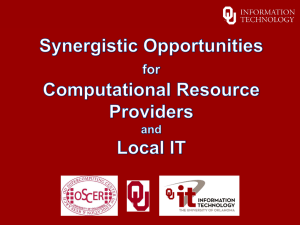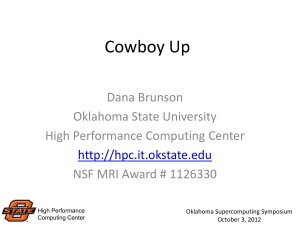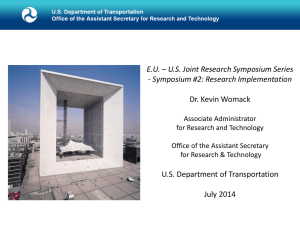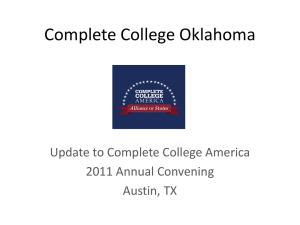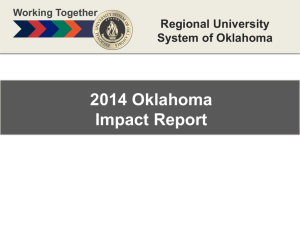PowerPoint - Oklahoma Supercomputing Symposium 2014
advertisement
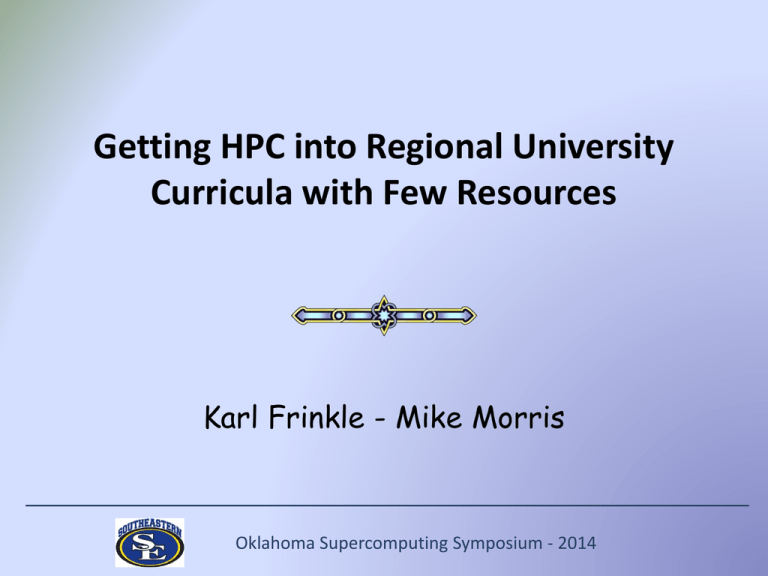
Getting HPC into Regional University Curricula with Few Resources Karl Frinkle - Mike Morris Oklahoma Supercomputing Symposium - 2014 Getting HPC into Regional University Curricula with Few Resources (Doing big things with little $$$) Karl Frinkle - Mike Morris Oklahoma Supercomputing Symposium - 2014 Some of our goals . . . Include parallel computing in our curriculum Follow ACM accreditation guidelines Allow early-CS and non-CS students to participate Develop permanent courses Exploit limited resources Oklahoma Supercomputing Symposium - 2014 Our Resources . . . Uhhhh . . . Oklahoma Supercomputing Symposium - 2014 3 courses seemed essential . . . Oklahoma Supercomputing Symposium - 2014 First we needed hardware. Cluster Oklahoma Supercomputing Symposium - 2014 http://littlefe.net 7 What is a LittleFe? BigFe LittleFe Remember, Fe = Iron Oklahoma Supercomputing Symposium - 2014 Then we needed software. Some sort of Linux. We used BCCD, (Bootable Cluster CD), an incarnation of Debian. Oklahoma Supercomputing Symposium - 2014 Getting a course approved . . . Oklahoma Supercomputing Symposium - 2014 Special Seminars fit our bill. CS4970 – Special Seminar CS4980 – Special Studies Immediate approval Upper level a concern . . . etc. Oklahoma Supercomputing Symposium - 2014 Back to the courses . . . Oklahoma Supercomputing Symposium - 2014 C with MPI C& MPI Course 1 We threw caution to the winds and assumed a “Hello World” was the extent of students’ skills. Oklahoma Supercomputing Symposium - 2014 C with MPI C& MPI Course 1 We threw caution to the winds and assumed a “Hello World” was the extent of students’ skills. We delivered a crash course in C, emphasizing array structures, memory management, binary storage and other fundamentals. Oklahoma Supercomputing Symposium - 2014 C with MPI C& MPI Course 1 We threw caution to the winds and assumed a “Hello World” was the extent of students’ skills. We did not emphasize things like formatted i/o and loop syntax – we gave them examples and let them run with these types of things. Oklahoma Supercomputing Symposium - 2014 C with MPI C& MPI Course 1 As an introduction to parallel programming, we took a parallel “Hello World” using MPI that Charlie Peck gave us and studied it extensively. Oklahoma Supercomputing Symposium - 2014 C with MPI C& MPI Course 1 The main parallel project topic of the first course was matrix multiplication. Oklahoma Supercomputing Symposium - 2014 C with MPI C& MPI Course 1 The main parallel project topic of the first course was matrix multiplication. Make no mistake – there is plenty of material in this seemingly simple problem for a plethora of programs. Oklahoma Supercomputing Symposium - 2014 matrix multiplication 3 8 6 4 0 8 4 0 1 8 5 6 2 9 2 9 4 1 6 6 3 5 0 1 7 5 0 7 0 0 8 4 8 6 9 7 x 6 2 2 9 4 5 7 8 4 0 2 0 5 0 7 5 8 9 4 9 6 0 6 1 3 5 5 0 7 2 0 4 4 1 5 6 = - - - - * - - Each cell of a product matrix is calculated independently of others, so the problem screams, “Parallelize me!” Oklahoma Supercomputing Symposium - 2014 C with MPI C& MPI Course 1 C fundamentals and the matrix problems were more than enough for a first course. We were pleasantly surprised at how naturally students seemed to accept the parallel models. Oklahoma Supercomputing Symposium - 2014 CUDA CUDA Course 2 Compute Unified Device Architecture CUDA is the computing engine developed by Nvidia for high speed graphics rendering and physics calculations. CUDA allows languages such as C/C++ to take advantage of highspeed GPUs in computationally intensive programs. Oklahoma Supercomputing Symposium - 2014 CUDA CUDA Course 2 We made the second course project based, and carefully chose a list of problems that would lend themselves to CUDA processing. Oklahoma Supercomputing Symposium - 2014 CUDA CUDA Course 2 We made the second course project based, and carefully chose a list of problems that would lend themselves to CUDA processing. But like in the first course, we started with a CUDA version of “Hello World” which worked quite well. Oklahoma Supercomputing Symposium - 2014 CUDA CUDA Course 2 We made the second course project based, and carefully chose a list of problems that would lend themselves to CUDA processing. For example: - More matrix multiplication - Large number multiplication - Prime number checking - Password cracking Oklahoma Supercomputing Symposium - 2014 more matrix multiplication 3 8 6 4 0 8 4 0 1 8 5 6 2 9 2 9 4 1 6 6 3 5 0 1 7 5 0 7 0 0 8 4 8 6 9 7 x 6 2 2 9 4 5 7 8 4 0 2 0 5 0 7 5 8 9 4 9 6 0 6 1 3 5 5 0 7 2 0 4 4 1 5 6 = - - - - * - - *=6x3+1x5+2x5+3x0+0x7+8x2 Each cell’s required data is sent to a processor with MPI code. That processor sends out all multiplications to the GPUs by using CUDA code. [Blue font color represents CUDA calculations.] Oklahoma Supercomputing Symposium - 2014 CUDA CUDA Course 2 Basing all projects on a shell obtained from our Hello World was a great method of generating programs. The projects were more than enough for a semester of work for the students. Oklahoma Supercomputing Symposium - 2014 High Performance Computing HPC Course 3 After getting a year of parallel programming under our belts, we decided to tackle a research-level math problem and make it the class project for an entire course. Oklahoma Supercomputing Symposium - 2014 High Performance Computing HPC Course 3 A colleague co-authored a mathematical paper studying the behavior of a particular class of functions as they traversed a path along a once-punctured torus. All values were complex numbers, and paths were integrated in the complex field, so computation was intensive. Oklahoma Supercomputing Symposium - 2014 High Performance Computing HPC Course 3 The problem was based upon a construction of a ternary tree based upon certain convergence criteria, and computations once again begged for parallelization. It worked! Oklahoma Supercomputing Symposium - 2014 High Performance Computing HPC Course 3 We got lots of help from the Oklahoma Supercomputer Center for Education and Research (OSCER). After we “perfected” our programs, we ran them on OU’s supercomputer, using up to 2,000 processors per run, racking up several CPU-years of run time. Oklahoma Supercomputing Symposium - 2014 Observations . . . • We used “Special Seminars” so we didn’t have to go through Curriculum Committees, etc. • Students adapted quickly to the parallel concept, even those of limited experience. • The association with Oklahoma University’s supercomputer people was invaluable. Oklahoma Supercomputing Symposium - 2014 Newest Course . . . • We are injecting a hardware component into the first course. • We have procured about 40 retired office computers and the students will build several clusters. • We’re not looking for speed, but we are demonstrating HPC techniques. Oklahoma Supercomputing Symposium - 2014 Up-to-theminute activities . . . We commandeered an old science lab! 33 Up-to-the-minute activities . . . Everyone has a sink! We catalogued and “fixed” the cast off computers. 34 Up-to-the-minute activities . . . We broke into 3 teams, each to build their own super computer! 35 Up-to-the-minute activities . . . Students love the format – per the latest pedagogy, we have a high entertainment value in the class. 36 Goals Accomplished - We’ve spent almost nothing. - We’ve delivered 4 separate HPC courses. - We’ve generated interest in permanent courses. - We’ve reached across disciplines. - We’ve stayed in accreditation guidelines. - We’re on the cutting edge of CS. 37 Thank You! We especially thank Henry Neeman, Charlie Peck, Tom Murphy, Bob Panoff and everyone else associated with OU IT, the LittleFe project, the SOSU IT guys and all of our colleagues and friends in the educational community involved with HPC, for all the help we have received. Karl Frinkle Mike Morris Oklahoma Supercomputing Symposium - 2014
